Experience Serenity at Fanjing Mountain: A Journey into Nature
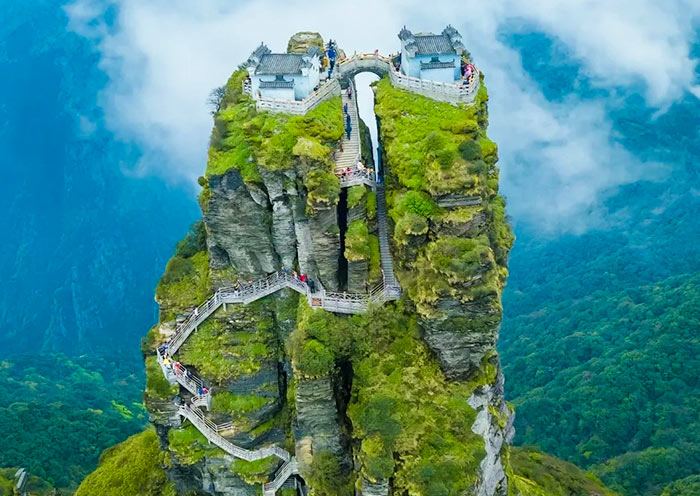
An Essential Guide to Visiting Fanjing Mountain
Nestled in the lush landscapes of Guizhou Province, Fanjing Mountain is a breathtaking sanctuary that beckons adventurers and spiritual seekers alike. Known as the “Pure Land of Brahma,” this sacred peak is one of China’s top five Buddhist mountains, where history, spirituality, and natural beauty converge in a spectacular display. Imagine standing atop towering cliffs that rise dramatically from a sea of verdant hills, gazing into the distance as misty clouds weave through the valleys below.
With a rich geological heritage that tells the story of ancient oceans and fiery volcanic activity, Fanjing Mountain offers more than just stunning views; it’s also a living testament to the earth’s dynamic forces. You’ll find yourself captivated by its unique rock formations, such as the iconic Mushroom Rock, which seems to defy gravity, and the majestic Red Cloud Golden Summit, where panoramic vistas await those brave enough to ascend its heights.
Whether you’re seeking spiritual enlightenment, exhilarating hikes, or simply a moment of tranquility surrounded by nature, Fanjing Mountain promises an unforgettable experience. As you embark on this journey, prepare to be enchanted by its serene temples, awe-inspiring landscapes, and the vibrant stories that echo through the ages. Welcome to a realm where adventure awaits at every turn, and the beauty of the natural world reveals itself in the most extraordinary ways.
In This Guide
- An Essential Guide to Visiting Fanjing Mountain
- The Rich History and Legends of Fanjing Mountain
- Main Highlights: What You Absolutely Can’t Miss
- Planning Your Visit: A Practical Guide
- Tickets: Prices, Booking, and Tips
- How to Get There: A Complete Transportation Guide
- Local Cuisine and Accommodation Nearby
- Frequently Asked Questions
- Final Thoughts on Your Trip
The Rich History and Legends of Fanjing Mountain
Fanjing Mountain, often referred to as the “Pure Land of Brahma,” is steeped in a rich tapestry of history and legends that draw travelers from around the globe. Nestled in the heart of Guizhou Province, this sacred peak not only captivates with its stunning vistas but also enchants with its storied past, deeply intertwined with Buddhism and local folklore.
A Sacred Sanctuary
Fanjing Mountain has long been recognized as one of China’s top five Buddhist mountains. The site has been a pilgrimage destination for centuries, attracting monks, scholars, and devotees seeking enlightenment and spiritual solace. The mountain’s prominence in Buddhist culture is marked by its numerous temples and shrines, which serve as a testament to the spiritual devotion that has flourished here. Among the most revered is the Fanjing Temple, believed to date back to the Ming Dynasty. This temple, along with others scattered across the mountain, is dedicated to the worship of the Buddha and serves as a gathering place for spiritual practices.
Geological Wonders and Myths
The geological formation of Fanjing Mountain itself is a story worth telling. Millions of years ago, this area was submerged under an ancient ocean, where volcanic eruptions and sedimentation shaped the land. The metamorphic rocks that constitute the mountain are remnants of this tumultuous past, standing defiantly against the eroding forces of nature. As the softer limestone surrounding it wore away, Fanjing emerged as a “rock island” rising majestically above the lush karst hills, creating a breathtaking landscape that is both visually stunning and geologically significant.
Legends abound regarding the mountain’s formation. One tale speaks of the divine intervention by the Bodhisattva Guanyin (Avalokiteshvara), who is said to have transformed the peak into a sacred land, a place where the heavens meet the earth. Locals believe that the mountain serves as a bridge between the spiritual and material realms, where the earthly and divine coexist in harmony.
Folklore and Legends
Fanjing Mountain is also steeped in local folklore, with stories that capture the imagination. One of the most enchanting legends recounts a lost traveler who, after wandering the rugged terrain, encountered a mystical figure who revealed the secrets of the mountain. This figure was often depicted as a wise monk or a celestial being, guiding those who seek enlightenment and purity of spirit.
Another popular tale is that of the “Buddha’s Light,” a rare phenomenon that occurs when sunlight refracts through the clouds and creates an ethereal glow, resembling the figure of a seated Buddha. Many believe that witnessing this spectacle brings good fortune and blessings from the heavens, further solidifying the mountain’s status as a spiritual sanctuary.
A Modern-Day Pilgrimage
In contemporary times, Fanjing Mountain has become a symbol of resilience and reverence, as efforts are made to preserve its unique natural and cultural heritage. The establishment of protected zones and sustainable tourism practices aims to ensure that the mountain remains a sacred space for future generations.
Visitors today are encouraged to engage with the mountain’s rich history through exploration of its ancient trails, temples, and the breathtaking natural wonders that surround them. Whether you’re seeking spiritual enrichment or simply a connection with nature, Fanjing Mountain’s storied past and vibrant legends offer an unforgettable experience that lingers long after the journey ends.
In conclusion, Fanjing Mountain is not just a destination; it’s a living testament to the intertwining of nature, spirituality, and history. As you stand atop its peaks, surrounded by mist and mystery, you can’t help but feel the weight of the ages and the whispers of countless souls who have tread the same paths in search of wisdom, peace, and connection to the divine.
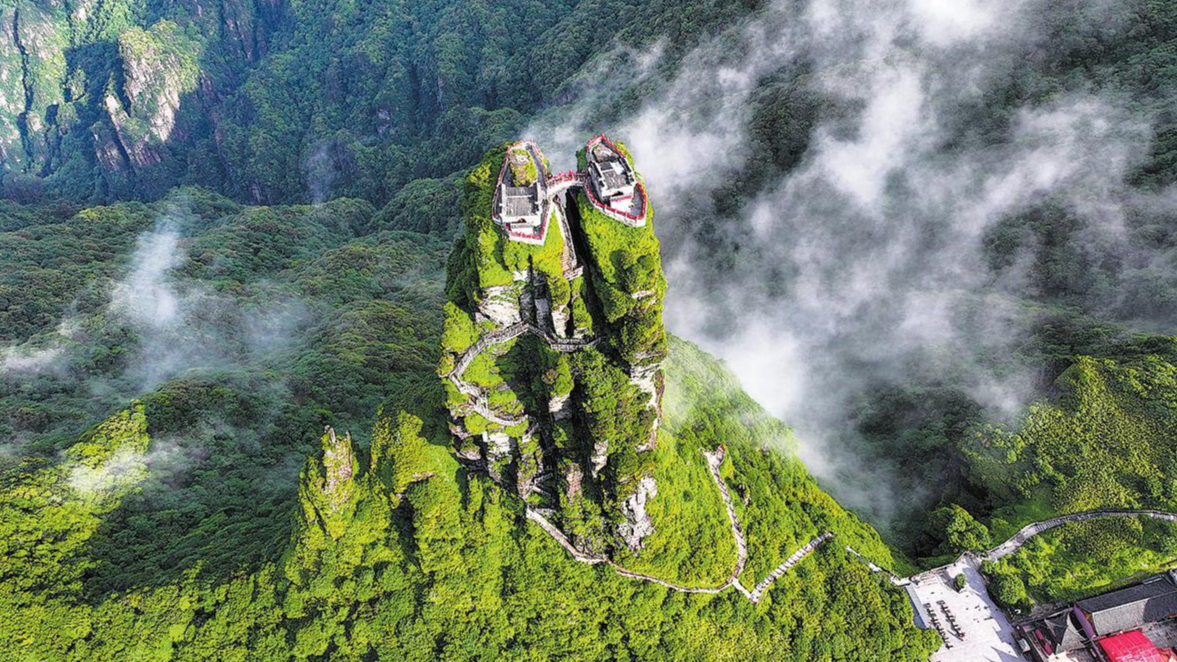
Fanjing Mountain.
Main Highlights: What You Absolutely Can’t Miss
Fanjing Mountain, or Fanjingshan, is a treasure trove of natural beauty and spiritual significance, making it a must-visit destination for international travelers. Nestled in the Guizhou Province, this sacred peak is renowned for its breathtaking views, unique rock formations, and rich cultural heritage. Here’s a curated list of the main highlights you absolutely can’t miss during your visit.
Red Cloud Golden Summit (红云金顶)
The crown jewel of Fanjing Mountain, the Red Cloud Golden Summit stands at an impressive 2,336 meters (7,734 feet). Ascending this towering rock feels like reaching the sky itself. The summit offers panoramic views of the mist-laden mountains and, on clear days, the rare phenomenon known as “Buddha’s Light,” where ethereal rays illuminate the landscape.
- Tip: The trail can be steep and narrow, with chains to help climbers. For a more leisurely ascent, take the scenic cable car ride, where you can soak in the vibrant greens of the mountain slopes below.
Mushroom Rock (蘑菇石)
A whimsical sight, Mushroom Rock resembles a giant mushroom, expertly balanced on a cliff’s edge. This geological wonder has stood the test of time and has become known as the “Stone of Love” for its enduring shape.
- Photo Opportunity: Capture this iconic formation as you hike along the forest boardwalk. Its unique shape against the backdrop of Fanjing’s sprawling hills provides the perfect shot for your travel album.
Old Golden Summit (老金顶)
For those seeking a quieter experience, the Old Golden Summit is an ideal retreat. This lesser-known peak offers stunning views of the Red Cloud Golden Summit, making it the perfect spot for photography enthusiasts looking to avoid the crowds.
- Legend: Known as Moon Mirror Mountain in ancient times, its reflective stones create a mystical atmosphere, especially during sunrise.
Sunrise Viewing
Experiencing a sunrise at Fanjing Mountain is nothing short of magical. With only about 100 days of sunshine each year, witnessing the first rays of light illuminate the peaks is a rare treat.
- Timing: Arrive before 6:00 AM and take the first cable car to secure the best vantage point. Dress warmly, as temperatures can drop significantly in the early hours.
Hiking Trails
Fanjing Mountain offers a variety of hiking routes catering to different skill levels. The West-Up, East-Down hike is a challenging yet rewarding option, taking you through diverse landscapes and leading to stunning vistas.
- For Beginners: Consider the West Gate Round Trip, which provides a scenic loop with less strenuous terrain. Both trails feature the famed Stairway of Ten Thousand Steps, a steep descent that is more manageable with a cable car ride down.
Peculiar Rock Formations
Beyond the famous peaks, Fanjing is home to a myriad of unusual rock formations that add to its charm. From the Sleeping Buddha stretching across the ridgeline to the ancient Pregnancy Tree adorned with red prayer ribbons, each formation tells a unique story.
Photography Spots
For those passionate about capturing the perfect shot, Fanjing Mountain is a photographer’s dream. Key locations include:
- Red Cloud Golden Summit: Ideal for sweeping landscape shots.
- Mushroom Rock: Perfect for quirky, fun images.
- The Ten-Thousand-Step Stairway: Offers dramatic angles of the surrounding peaks.
Nature and Spirituality
Fanjing Mountain is not just about stunning views; it is also a site of deep spiritual significance. As one of China’s top five Buddhist mountains, it attracts both pilgrims and nature lovers. The tranquil temples scattered throughout the landscape provide a peaceful respite from hiking.
Conclusion
With its stunning vistas, unique rock formations, and rich spiritual history, Fanjing Mountain promises an unforgettable adventure. Whether you’re hiking to the summits, capturing the sunrise, or simply soaking in the serene environment, this sacred peak is a destination you won’t want to miss on your travels through China.
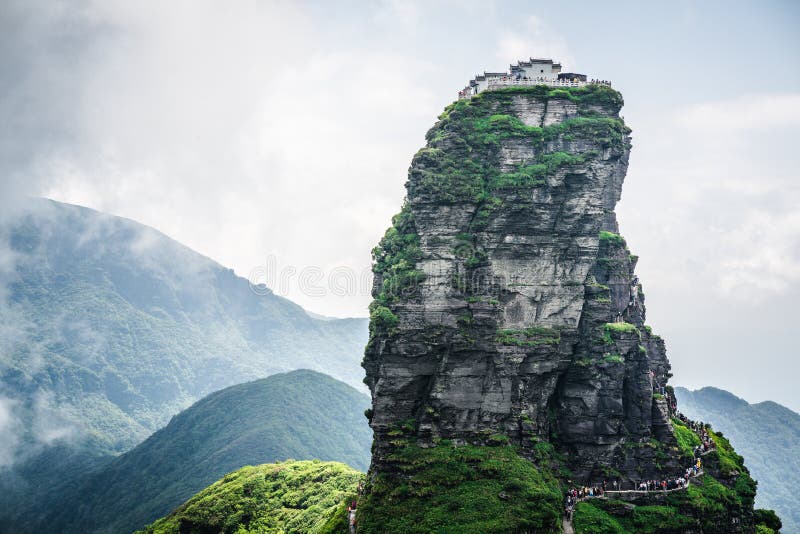
Fanjing Mountain.
Planning Your Visit: A Practical Guide
Your Practical Guide to Visiting Fanjing Mountain
Fanjing Mountain (梵净山) is a breathtaking destination that beautifully combines natural wonders with spiritual significance. To ensure your visit is smooth and enjoyable, here’s a comprehensive guide packed with essential information, tips, and insights.
Getting There
Fanjing Mountain is located approximately 60 kilometers from Tongren in Guizhou Province, where three counties converge: Jiangkou, Yinjiang, and Songtao. The easiest way to reach Fanjing is by flying into Tongren Fenghuang Airport, followed by a taxi or bus ride to the mountain entrance.
Transportation Options:
– By Air: Fly into Tongren Fenghuang Airport. From there, you can take a taxi or a local bus to the mountain.
– By Train: The nearest train station is in Tongren. From the station, you can catch a bus or taxi to the mountain.
– By Bus: Local buses run regularly from Tongren to the Fanjing Mountain area.
Ticketing Information
To visit Fanjing Mountain, you will need to purchase an entrance ticket and, depending on your plans, additional tickets for the sightseeing bus and cable car.
Ticket Prices:
– Entrance Ticket: ¥100
– Sightseeing Bus: ¥48 (mandatory for entry)
– Cable Car (one-way): ¥70 (optional)
– Cable Car (round trip): ¥140 (optional)
Peak vs. Off-Season Pricing:
– Peak Season (March–November): Approximately ¥280 total for a combo ticket.
– Off-Season (December–February): Approximately ¥200 total.
Booking Tips:
– Book tickets online at least 7 days in advance for a guaranteed entry. Same-day tickets may be limited.
– If you prefer to buy tickets on-site, arrive early, especially during peak seasons, as daily visitor limits apply (8,000 for East Gate and 1,000 for West Gate).
Best Time to Visit
The ideal time to explore Fanjing Mountain is during spring and autumn when the weather is mild, and the scenery is particularly stunning. Summer can be hot, while winter may bring chilly temperatures, so dress accordingly.
Sunrise Enthusiasts: If you’re keen on witnessing the magical sunrise, arrive before 6:00 AM and consider staying in a guesthouse nearby for early access.
Hiking Routes
Fanjing Mountain offers a variety of hiking trails, each catering to different levels of fitness and experience.
- West-Up, East-Down Hike:
- Duration: Approximately 6.5 hours.
- Difficulty: Challenging, with steep climbs and descent via the “Stairway of Ten Thousand Steps.”
-
Highlights: Old Golden Summit and breathtaking views.
-
West Gate Round Trip:
- Duration: 7 to 9 hours.
- Difficulty: Moderate to challenging.
- Highlights: Scenic loop through wild forests and famous rock formations like Mushroom Rock.
Essential Hiking Tips:
– Wear sturdy hiking shoes.
– Bring plenty of water and snacks.
– Be mindful of monkeys along the trail—they can be entertaining but may slow your pace.
Key Attractions
-
Red Cloud Golden Summit: The most iconic peak at Fanjing, offering stunning panoramic views. Prepare for a steep climb and consider taking the cable car for a less strenuous ascent.
-
Mushroom Rock: A gravity-defying rock formation that is perfect for photography. Make sure to stop here for stunning shots along your hiking route.
-
Old Golden Summit: A quieter spot offering the best views of Red Cloud and fewer crowds, ideal for capturing that perfect photo.
Safety Tips
- Weather Awareness: Conditions can change rapidly at higher elevations. Always carry a light jacket, even in summer, as it can get chilly at the top.
- Stay on Designated Trails: To preserve the natural landscape and for your safety, stick to marked hiking paths.
- Hydration: Drink plenty of water, particularly if you’re hiking. It’s easy to become dehydrated in the high altitudes.
Photography Tips
Fanjing Mountain is a photographer’s paradise. To capture its beauty:
– Focus on early morning or late afternoon for the best lighting.
– Use the rule of thirds for balanced compositions.
– Experiment with different angles to showcase the dramatic landscape.
Final Thoughts
Visiting Fanjing Mountain is not just about enjoying breathtaking views; it’s about immersing yourself in a landscape steeped in history and spirituality. With this practical guide, you’re well-equipped to make the most of your journey to one of China’s most stunning natural wonders. Enjoy your adventure!
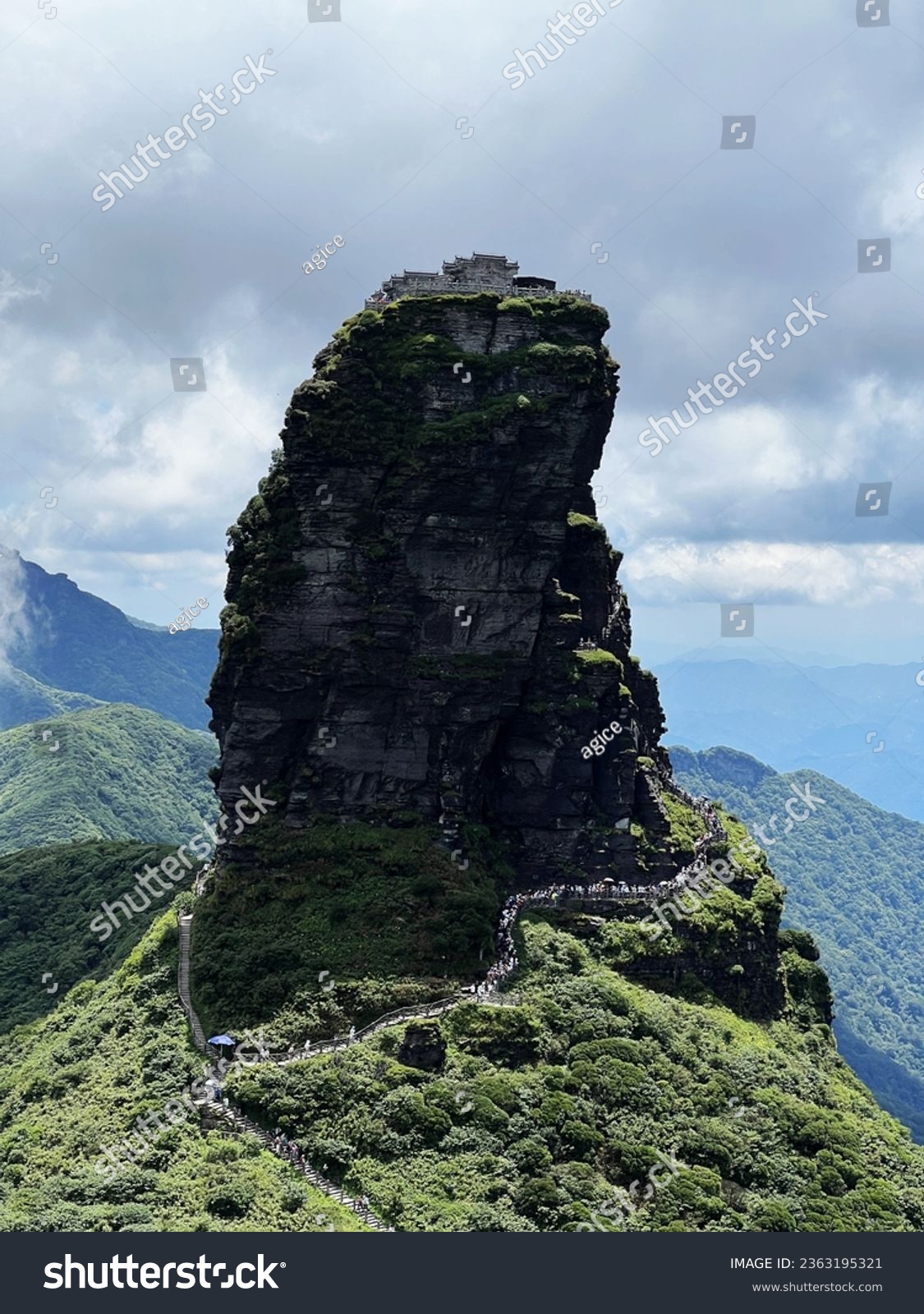
Fanjing Mountain.
Tickets: Prices, Booking, and Tips
When planning your journey to the breathtaking Mount Fanjing, understanding the ticketing process is essential for a smooth experience. Here’s everything you need to know about ticket prices, booking options, and handy tips to ensure your visit is as enjoyable as the stunning views that await.
Ticket Prices & Options
Entrance Ticket: ¥100
This ticket is mandatory for all visitors.
Sightseeing Bus: ¥48
This bus ticket is required to access the mountain, even if you qualify for free entry.
Cable Car (One-way): ¥70 (Optional)
Cable Car (Round Trip): ¥140 (Optional)
The cable car provides a scenic ascent, making it a popular choice among travelers.
Seasonal Pricing
- Peak Season (March–November): Approximately ¥280 total for a combo ticket.
- Off-Season (December–February): Approximately ¥200 total.
Visitor Limits
Due to the mountain’s stunning appeal, there are daily visitor limits:
– East Gate: 8,000 people/day
– West Gate: 1,000 people/day
Opening Hours
- East Gate: 7:00 AM – 3:00 PM (Cable car access available)
- West Gate: 7:00 AM – 1:00 PM (Hiking only)
How to Book Tickets
Online Booking
- 7 Days in Advance: 2,000 tickets available, released at 6:30 AM daily.
- 3 Days in Advance: 3,500 tickets available, released at 6:30 AM daily.
- Same-Day Booking: A few hundred tickets available, but not always guaranteed.
Offline Booking
- 2 Days in Advance: 500 tickets available at the visitor center.
- 1 Day or Same-Day: Up to 2,500 tickets may be released the next morning if any remain.
Cable Car Tickets
Cable car tickets can be purchased either online or directly at the cable car station.
Booking Tips
- Book in Advance: Especially during peak season, securing your tickets early is crucial.
- Arrive Early: If you’re planning to catch the sunrise or visit popular spots, arriving before the gates open helps avoid the crowds.
- Dress Accordingly: It can get chilly at higher altitudes, so pack a light jacket for your visit.
Final Thoughts
Mount Fanjing is not just a mountain; it’s a treasure trove of natural beauty and spiritual significance. By planning your ticketing strategy wisely, you can focus on the awe-inspiring landscapes and serene experiences that await you. Enjoy your adventure amidst the clouds!
How to Get There: A Complete Transportation Guide
Getting to Mount Fanjing is an adventure in itself, as the mountain is nestled in the picturesque Guizhou Province of China. Whether you’re traveling from the major cities or nearby towns, this complete transportation guide will help you navigate your way to this sacred and stunning destination.
By Air
The closest major airport to Mount Fanjing is Tongren Fenghuang Airport (TEN), located about 60 kilometers away. International travelers usually connect through larger hubs like Guangzhou Baiyun International Airport (CAN) or Chengdu Shuangliu International Airport (CTU).
- Arriving at Tongren Fenghuang Airport:
- After landing, you can take a taxi or arrange a private transfer to Mount Fanjing. The drive will take approximately 1.5 hours.
By Train
If you prefer the scenic route, there are several train stations near Tongren where you can arrive by rail:
- Tongren Railway Station:
- High-speed trains from major cities like Chengdu, Guiyang, and Kunming frequently arrive here.
-
Upon arrival, you can take a taxi or a local bus to reach Mount Fanjing.
-
Getting to Mount Fanjing from Tongren:
- Taxi: The most convenient option, costing about 150-200 RMB and taking around 1 hour.
- Public Bus: A more economical but longer option. Look for buses heading to Jiangkou County or Fanjingshan Scenic Area.
By Bus
For budget-conscious travelers, long-distance buses are available from various cities:
- From Guiyang:
-
Buses operate regularly from Guiyang’s Long-distance Bus Station to Tongren. The journey takes about 3-4 hours. Once in Tongren, follow the taxi or bus instructions above to reach Mount Fanjing.
-
From Tongren:
- From Tongren, you can catch a local bus directly to Mount Fanjing Scenic Area. Buses depart throughout the day, and the journey takes about 1.5 hours.
Getting Around Mount Fanjing
Once you arrive at Mount Fanjing, there are several options to explore the area:
- Sightseeing Bus:
-
Upon entry, you’ll need to purchase a sightseeing bus ticket (¥48) that takes you to the starting point of the hiking trails. This is a must as private vehicles are not allowed on scenic routes.
-
Cable Car:
-
For a breathtaking ascent, consider the cable car ride (¥70 one-way or ¥140 round-trip) that offers stunning views as it climbs toward the peaks.
-
Hiking:
- Mount Fanjing is best explored on foot. There are various trails ranging from moderate to challenging, so be prepared for a day of adventure.
Travel Tips
- Book in Advance: During peak seasons (March to November), it’s advisable to book your tickets online ahead of time, especially for the cable car and entrance.
- Check the Weather: Conditions can change rapidly, so dress in layers and bring a light jacket, even in summer.
- Plan for Crowds: Arrive early to beat the rush, especially if you want to catch the sunrise or enjoy the trails peacefully.
With its mystical landscapes and spiritual significance, Mount Fanjing is sure to provide an unforgettable experience. By following this transportation guide, you’re well on your way to exploring one of China’s hidden treasures!
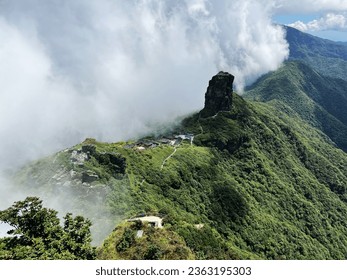
Fanjing Mountain.
Local Cuisine and Accommodation Nearby
When it comes to exploring the breathtaking landscapes of Mount Fanjing, indulging in the local cuisine and finding a comfortable place to stay is just as essential as the hiking trails and stunning views. The area surrounding this sacred mountain is a treasure trove of culinary delights and charming accommodations that will enhance your travel experience.
Savoring Local Flavors
Guizhou Cuisine is renowned for its bold flavors, vibrant colors, and a delightful variety of dishes that reflect the region’s diverse ethnic culture. Here are some must-try local specialties:
-
Sour Soup Fish (酸汤鱼): This signature dish features fresh fish cooked in a tangy, spicy broth made from fermented rice and local herbs. It’s a perfect way to warm up after a day of hiking!
-
Spicy Chicken (辣子鸡): Tender chicken pieces are stir-fried with a generous amount of dried chili peppers and various spices, delivering a fiery kick that spice lovers will adore.
-
Mushroom Hot Pot (蘑菇火锅): With the region’s abundant mushrooms, a hot pot filled with a medley of fresh fungi, vegetables, and thinly sliced meats is a communal dining experience that’s not to be missed. Dip your ingredients into a bubbling broth for rich flavors.
-
Sticky Rice (黏米饭): Local sticky rice, often served with savory fillings or wrapped in bamboo leaves, is a staple that complements many dishes.
To get the full experience, consider dining at one of the local restaurants in Tongren or nearby villages. Tianlong Lou Restaurant and Guizhou Specialty Restaurant are popular choices among travelers, offering a cozy atmosphere and authentic dishes that will satisfy your hunger after a day of exploration.
Charming Accommodations
Finding a comfortable place to rest after a day of hiking is crucial. Fortunately, the vicinity of Mount Fanjing offers a range of accommodations catering to different budgets and preferences:
-
Fanjing Mountain Hotel: Located conveniently near the mountain entrance, this hotel provides modern amenities and stunning views of the surrounding landscape. It’s an ideal base for early morning hikes, with breakfast options to fuel your adventures.
-
Tongren Yunding Holiday Hotel: This charming hotel features comfortable rooms and a warm, welcoming atmosphere. It’s a great choice for families or groups, offering spacious accommodations and easy access to local attractions.
-
Homestays: For a more local experience, consider staying in one of the homestays run by families in the nearby villages. Not only will you enjoy a cozy atmosphere, but you’ll also get the chance to savor homemade meals and gain insights into local culture. Bamboo Grove Homestay is known for its hospitality and traditional decor.
-
Hostels: If you’re traveling on a budget, look for hostels in Tongren. Fanjing Mountain Youth Hostel offers dormitory-style rooms and is a great place to meet fellow travelers while sharing stories about your adventures.
Final Thoughts
Whether you’re savoring the spicy delights of Guizhou cuisine or resting in a cozy accommodation, the experiences surrounding Mount Fanjing will enrich your journey. Be sure to take some time to explore the local flavors and hospitality, making your visit not just about the views, but also about the culture and community that thrives in this beautiful region.
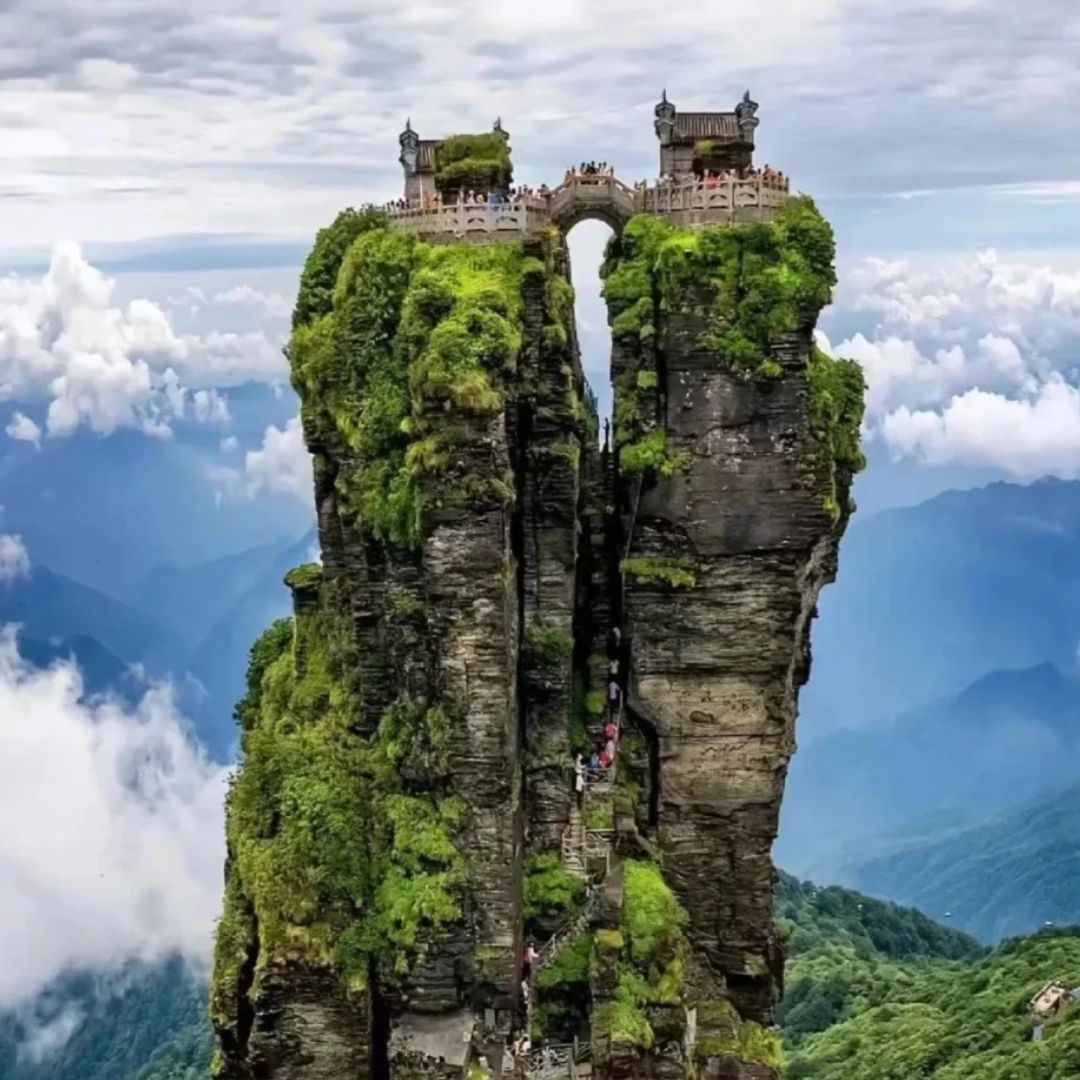
Fanjing Mountain.
Frequently Asked Questions
Frequently Asked Questions about Fanjing Mountain
1. How do I get to Mount Fanjing?
Mount Fanjing is located about 60 kilometers from Tongren city in Guizhou Province. The most convenient way to reach the mountain is by taking a taxi or a local bus from Tongren. If you’re traveling from other cities, consider taking a train or flight to Tongren first.
2. What are the best times to visit Mount Fanjing?
The ideal time to visit is during the spring (March to May) and autumn (September to November) when the weather is mild, and the scenery is at its best. Peak season lasts from March to November, so be prepared for larger crowds during these months.
3. Are there accommodations near Mount Fanjing?
Yes, there are several guesthouses and hotels in the nearby area, particularly in Tongren. Staying close to the entrance of the mountain can help you get an early start for sunrise hikes. It’s advisable to book in advance, especially during peak season.
4. What should I wear for hiking on Mount Fanjing?
Dress in layers, as temperatures can change significantly throughout the day. Comfortable, sturdy hiking shoes are a must due to the rocky terrain. Don’t forget a light jacket for cooler temperatures at higher elevations and bring sun protection like a hat and sunscreen.
5. How challenging are the hikes on Mount Fanjing?
Mount Fanjing offers various trails, catering to different skill levels. The West-Up, East-Down hike is more challenging and best for experienced hikers, while the West Gate Round Trip is a scenic loop that is moderately challenging. Always assess your fitness level before embarking on the trails.
6. Do I need to book tickets in advance?
Yes, it is recommended to book tickets in advance, especially during peak seasons when daily visitor limits apply. You can purchase tickets online up to seven days in advance. If you’re visiting in the off-season, same-day tickets may be available, but it’s safer to plan ahead.
7. Is there a cable car, and how does it work?
Yes, there is a cable car that takes you up to the Red Cloud Golden Summit. It’s a convenient option for those who want to enjoy the views without the strenuous hike. Tickets can be purchased separately, and it’s advisable to buy them online or at the station to avoid long queues.
8. Are there any safety precautions I should take while hiking?
Absolutely! Always stay on marked trails, and be cautious of slippery rocks and steep drops, especially after rain. It’s wise to hike with a buddy and carry enough water, snacks, and a first-aid kit. Lastly, keep an eye out for monkeys along the trails—they may be cute, but they can be unpredictable!
Final Thoughts on Your Trip
As you prepare to leave the breathtaking vistas and spiritual serenity of Mount Fanjing, take a moment to reflect on the experiences that have woven themselves into the fabric of your journey. From the majestic Red Cloud Golden Summit, where you stood above the clouds, to the whimsical Mushroom Rock, each site has offered a unique glimpse into the natural artistry of this hidden gem.
The magic of Fanjing Mountain isn’t just in its stunning landscapes but also in the stories etched into its ancient stones and the tranquil atmosphere that invites contemplation and connection. Whether you’ve hiked the challenging trails, captured postcard-perfect photographs, or simply soaked in the ethereal beauty of the surroundings, this sacred mountain has a way of leaving an indelible mark on your spirit.
As you descend back into the bustling world, carry with you the peace and inspiration found among these towering peaks. Share your tales of adventure and reflection with fellow travelers, and let the essence of Mount Fanjing influence your future journeys. This is not merely a destination, but a transformative experience that beckons you to return, time and again, to uncover more of its hidden wonders. Safe travels, and may your next adventure be just as extraordinary!